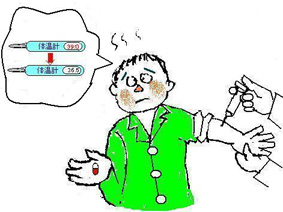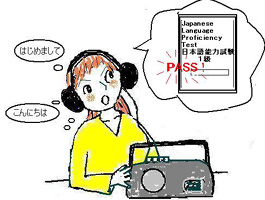Japanese
* JAPNESE HOME PAGE IS HERE
tameni/youni
A student made the following sentences.
gTokyo Daigaku ni hairu yoo ni ganbarimasuh
gNihongo ga joozu ni hanaseru tameni isshookenmei benkyoo shimasuh
Do you think these sentences are correct ?
This month wefll learn these gtame(ni)fand gyoonif which are used to express a purpose.
Clause/phrase before [tameni/youni] indicates the purpose or the goal and a main clause indicates a volitional action to attain that objective or to get closer to that objective.
[Tame (ni)]
The dictionary form of a volitional verb should be used before gtame(ni) and a negative-form(nai-form) of a verb seldom before it. Subject of a sentence and the actor of a verb before gtame(ni)h are usually the same.

- Ie o kau tameni chokinshiteimasu.
(Ifm saving money to buy a house.)
- Daigaku ni hairu tameni benkyooshiyoo
(Ifll study hard to enter the university.)
- Netsu o sageru tameni kusuri o nondari chuusya o shitari shimashita
(I took medicine and had an injection to lower my
temperarure.)
- Ikiru tameni hatarakanakerebanarani.
(I have to work to live.)
- Inu no sampo o suru tameni hayaku okimasu.
- (I get up early to take my dog for a walk.)

- Tsuma o yorokobaseru tameni yubiwa o kaimashita.
- (I bought a ring to please my wife).
- Ii spiichi o suru tameni mainichi rensyuu shiteimasu.
- (I practice every day to make a good speech.)
- Nihon o motto yoku shiru tameni nihon ni ryuugakushita.
- (Ifm studying in Japan to know more about Japan.)
- Nihongo no bunpoo o wakaraseru tameni e o tsukatte setsumeishimasu.
(The teacher explains with pictures to the students to make them understand Japanese grammar.)
- Musuko wa sakkaa no shiai o miru tameni kyou wa hayaku kaettekimashita.
- (My son came home early to watch the soccer game.)
- Asa rokuji no nihongokooza o kiku tameni rajio o setto shiteokimasu
(I set the timer of the radio for six to listen to the Japanese lecture .
[yooni]
The dictionary form of non-volitional verbs which express state such as potential verbs,dekiru,wakaru,mieru,kikoeru and etc. And the negative form of verbs are used before yooni. The subject of a sentence and that of clause before yooni are not always the same.

- Ii seiseki ga toreru yooni mainichi benkyooshinasai.
(You should study every day so that you can get a good score).
- Kono kiji ga oozei no hito ni yomareru yooni keijiban ni hatte okimasyoo.
- (If ll put this article on a notice board so that itfll be read by many people.)
- Gakko ni chikokushinai yooni mezamashi-dokei o kakete okimasu,
- (I set an alarm clock so that I wonft be late for school.)
- Netsu ga sagaru yooni kusuri o nondari cyuusya o shitari shimashita.
- (I took medicine and had an injection so that my temperature would drop.)
- Ii supiichi ga dekiru yooni mainichi rensyuu shiteimasu.
- (I practice every day so that Ifll be able to make a good speech,)
- Nihongo ga joozuni naru yooni teepu o kiiteimasu.
- (I listen to a tape so that Ifll improve my Japanese.)

- Kodomo ga sawaranai yooni abunai mono wa takai tokoroni okimasu.
- (I put dangerous things on the high shelf so that children wonft reach them,)
- Heya niwa kodomo ga yorokobu yooni doobutsu no e ga kaketearimasu.
- iThere are pictures of animals on the wall of kidfs room to please the children.j
- Nihongo no bunpoo ga wakaru yooni sensei wa e o tsukatte setsumeishite kuremashita.
- (The teacher explained with pictures so that the students might understand Japanese Grammar.)
- Ushiro no hito nimo mieru yooni kokuban no ji wa ookiku kaitekudasai.
- (Please write large letters on the blackboard so that the students in the back seats can see well.)
- Yoku kikoeru yooni rajikase no oto o ookikushimasu.
- (I turn up the radio cassette player so that I can hear well.)
There are some verbs which can be either volitional or
non-volitional. In this case either [tameni] or [yooni] can be used as the following sentences show.
 Yaseru tameni daietto o shiteimasu.
Yaseru tameni daietto o shiteimasu.
Yaseru yooni daietto o shiteimasu.
(Ifm on a diet to be slim.)
Nihon no seikatsu ni nareru tameni nihonjin no ie ni geshukushimasu,
Nihon no seikatsu ni nareru yooni nihonjin no ie ni geshuku shimasu,
(I stay with a Japanese family to get accustomed to Japanese life.)
Questions
- Byooki o naosu( )ni shujutsu o ukemashita.
- Tanoshii paatii ni naru( )ni geemu o suru kotoni shimashita.
- Kyanpu o suru( )ni shokuryoo o takusan yooishimashita.
- Ojiisan wa katai momo o taberareru ( )ni hao naoshimashita.
- Konsaato no kippu o toru( )ni nandomo denwashita.
- Shihatsu-densha ni noru( )ni asa hayaku shuppatsushita.
- Kenkoo o ijidekiru( )ni mainichi undooshite imasu.
- Koibito e no purezento o kau( )ni depaato ni ikimashita.
- Wasurenai( )ni memo o torimasu.
- Musuko ga joobuni naru( )ni suiei o narawasemashita.
- Kyooshi ni naru( )ni kyooshokukatei no jugyoo o totte imasu.
- Kyooshi ni nareru( )ni kyooshokukatei no jugyoo o totte imasu.
@@@@
(Answers)
1 tame 2 yoo 3 tame 4 yoo 5 tame
6 tame 7 yoo 8 tame 9 yoo@
10@yoo (yoo indicates a situation in this case.)
11 tame( tame indicates the volitional form in this case.)@@
12 yoo(gnareruh is the potential form of gnaruh)
We are expert Japanese teachers. We are confident that this article is good
and useful for foreign learners of Japanese. But we are afraid our English is
not so good. When you find any spelling or grammatical mistake,
please let us know.
We also offer private lessons for students of all levels.
Tel:03-3425-2478 (Matsuyama)
For more information , please e-mail us.
EMAIL: o1779uma@ca2.so-net.ne.jp
 /// JAPAN CULTURE STUDY GROUP ///
/// JAPAN CULTURE STUDY GROUP ///
RETURN TO COVER





 Yaseru tameni daietto o shiteimasu.
Yaseru tameni daietto o shiteimasu. /// JAPAN CULTURE STUDY GROUP ///
/// JAPAN CULTURE STUDY GROUP ///